Ancient Greek Sculpture › Early Christianity › Ancient Greek Pottery » Origins and History
Articles and Definitions › Contents
- Ancient Greek Sculpture › Origins
- Early Christianity › Origins
- Ancient Greek Pottery › Origins
Ancient civilizations › Historical places, and their characters
Ancient Greek Sculpture › Origins
Definition and Origins
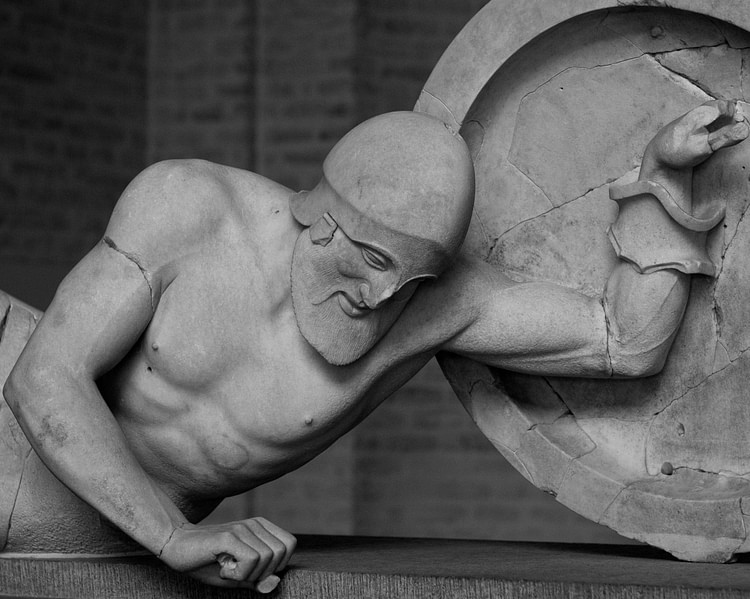
The sculpture of ancient Greece from 800 to 300 BCE took early inspiration from Egyptian and Near Eastern monumental art, and over centuries evolved into a uniquely Greek vision of the art form. Greek artists would reach a peak of artistic excellence which captured the human form in a way never before seen and which was much copied. Greek sculptors were particularly concerned with proportion, poise, and the idealised perfection of the human body, and their figures in stone and bronze have become some of the most recognisable pieces of art ever produced by any civilization.
INFLUENCES & EVOLUTION
From the 8th century BCE, Archaic Greece saw a rise in the production of small solid figures in clay, ivory, and bronze. No doubt, wood too was a commonly used medium but its susceptibility to erosion has meant few examples have survived.Bronze figures, human heads and, in particular, griffins were used as attachments to bronze vessels such as cauldrons. In style, the human figures resemble those in contemporary Geometric pottery designs, having elongated limbs and a triangular torso. Animal figures were also produced in large numbers, especially the horse, and many have been found across Greece at sanctuary sites such as Olympia and Delphi, indicating their common function as votive offerings.
The oldest Greek stone sculptures (of limestone) date from the mid-7th century BCE and were found at Thera. In this period, bronze free-standing figures with their own base became more common, and more ambitious subjects were attempted such as warriors, charioteers, and musicians. Marble sculpture appears from the early 6th century BCE and the first monumental, life-size statues began to be produced. These had a commemorative function, either offered at sanctuaries in symbolic service to the gods or used as grave markers.
The earliest large stone figures ( kouroi - nude male youths and kore - clothed female figures) were rigid as in Egyptian monumental statues with the arms held straight at the sides, the feet are almost together and the eyes stare blankly ahead without any particular facial expression. These rather static figures slowly evolved though and with ever greater details added to hair and muscles, the figures began to come to life.
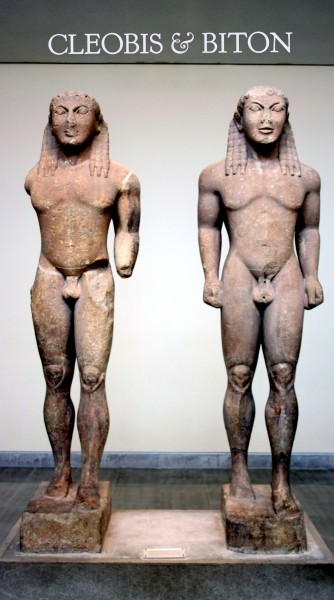
Cleobis & Biton
Slowly, arms become slightly bent giving them muscular tension and one leg (usually the right) is placed slightly more forward, giving a sense of dynamic movement to the statue. Excellent examples of this style of figure are the kouroi of Argos, dedicated at Delphi (c. 580 BCE). Around 480 BCE, the last kouroi become ever more life-like, the weight is carried on the left leg, the right hip is lower, the buttocks and shoulders more relaxed, the head is not quite so rigid, and there is a hint of a smile.Female kore followed a similar evolution, particularly in the sculpting of their clothes which were rendered in an ever-more realistic and complex way. A more natural proportion of the figure was also established where the head became 1:7 with the body, irrespective of the actual size of the statue. By 500 BCE Greek sculptors were finally breaking away from the rigid rules of Archaic conceptual art and beginning to re-produce what they actually observed in real life.
SCULPTORS STRIVED TO MAKE THE PIECE SEEM CARVED FROM THE INSIDE RATHER THAN CHISELLED FROM THE OUTSIDE.
In the Classical period, Greek sculptors would break off the shackles of convention and achieve what no-one else had ever before attempted. They created life-size and life-like sculpture which glorified the human and especially nude male form. Even more was achieved than this though. Marble turned out to be a wonderful medium for rendering what all sculptors strive for: that is to make the piece seem carved from the inside rather than chiselled from the outside. Figures become sensuous and appear frozen in action; it seems that only a second ago they were actually alive. Faces are given more expression and whole figures strike a particular mood. Clothes too become more subtle in their rendering and cling to the contours of the body in what has been described as 'wind-blown' or the 'wet-look'. Quite simply, the sculptures no longer seemed to be sculptures but were figures instilled with life and verve.
MATERIALS & METHODS
To see how such realism was achieved we must return again to the beginning and examine more closely the materials and tools at the disposal of the artist and the techniques employed to transform raw materials into art.
Early Greek sculpture was most often in bronze and porous limestone, but whilst bronze seems never to have gone out of fashion, the stone of choice would become marble. The best was from Naxos - close-grained and sparkling, Parian (from Paros ) - with a rougher grain and more translucent, and Pentelic (near Athens ) - more opaque and which turned a soft honey colour with age (due to its iron content). However, stone was chosen for its workability rather than its decoration as the majority of Greek sculpture was not polished but painted, often rather garishly for modern tastes.
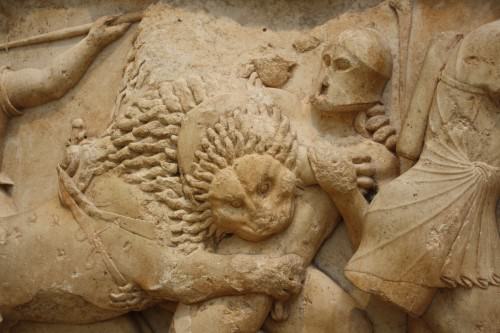
Gigantomachy of Delphi
Marble was quarried using bow drills and wooden wedges soaked in water to break away workable blocks. Generally, larger figures were not produced from a single piece of marble, but important additions such as arms were sculpted separately and fixed to the main body with dowels. Using iron tools, the sculptor would work the block from all directions (perhaps with an eye on a small-scale model to guide proportions), first using a pointed tool to remove more substantial pieces of marble. Next, a combination of a five-claw chisel, flat chisels of various sizes, and small hand drills were used to sculpt the fine details. The surface of the stone was then finished off with an abrasive powder (usually emery from Naxos) but rarely polished. The statue was then attached to a plinth using a lead fixture or sometimes placed on a single column (eg the Naxian Sphinx at Delphi, c. 560 BCE). The finishing touches to statues were added using paint. Skin, hair, eyebrows, lips, and patterns on clothing were added in bright colours. Eyes were often inlaid using bone, crystal, or glass. Finally, additions in bronze might be added such as spears, swords, helmets, jewellery, and diadems, and some statues even had a small bronze disc ( meniskoi ) suspended over the head to prevent birds from defacing the figure.
The other favoured material in Greek sculpture was bronze. Unfortunately, this material was always in demand for re-use in later periods, whereas broken marble is not much use to anyone, and so marble sculpture has better survived for posterity.Consequently, the quantity of surviving examples of bronze sculpture (no more than twelve) is not perhaps indicative of the fact that more bronze sculpture may well have been produced than in marble and the quality of the few surviving bronzes demonstrates the excellence we have lost. Very often at archaeological sites we may see rows of bare stone plinths, silent witnesses to art's loss.
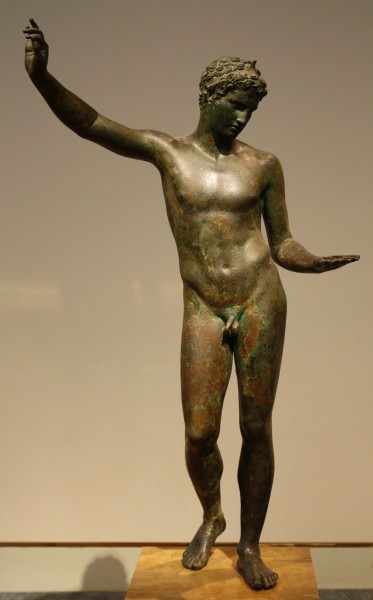
Bronze Greek Athlete
The early solid bronze sculptures made way for larger pieces with a non-bronze core which was sometimes removed to leave a hollow figure. The most common production of bronze statues used the lost-wax technique. This involved making a core almost the size of the desired figure (or body part if not creating a whole figure) which was then coated in wax and the details sculpted. The whole was then covered in clay fixed to the core at certain points using rods. The wax was then melted out and molten bronze poured into the space once occupied by the wax. When set, the clay was removed and the surface finished off by scraping, fine engraving and polishing. Sometimes copper or silver additions were used for lips, nipples and teeth. Eyes were inlaid as in marble sculpture.
MANY GREEK STATUES ARE SIGNED SO THAT WE KNOW THE NAMES OF THE MOST SUCCESSFUL ARTISTS WHO BECAME FAMOUS IN THEIR OWN LIFETIMES.
SCULPTORS
Many statues are signed so that we know the names of the most successful artists who became famous in their own lifetimes.Naming a few, we may start with the most famous of all, Phidias, the artist who created the gigantic chryselephantine statues of Athena (c. 438 BCE) and Zeus (c. 456 BCE) which resided, respectively, in the Parthenon of Athens and the Temple of Zeus at Olympia. The latter sculpture was considered one of the seven wonders of the ancient world. Polykleitos, who besides creating great sculpture such as the Doryphoros (Spearbearer), also wrote a treatise, the Kanon, on techniques of sculpture where he emphasised the importance of correct proportion. Other important sculptors were Kresilas, who made the much-copied portrait of Pericles (c. 425 BCE), Praxiteles, whose Aphrodite (c. 340 BCE) was the first full female nude, and Kallimachos, who is credited with creating the Corinthian capital and whose distinctive dancing figures were much copied in Roman times.
Sculptors often found permanent employment in the great sanctuary sites and archaeology has revealed the workshop of Phidias at Olympia. Various broken clay moulds were found in the workshop and also the master's own personal clay mug, inscribed 'I belong to Phidias'. Another feature of sanctuary sites was the cleaners and polishers who maintained the shiny reddish-brass colour of bronze figures as the Greeks did not appreciate the dark-green patina which occurs from weathering (and which surviving statues have gained).
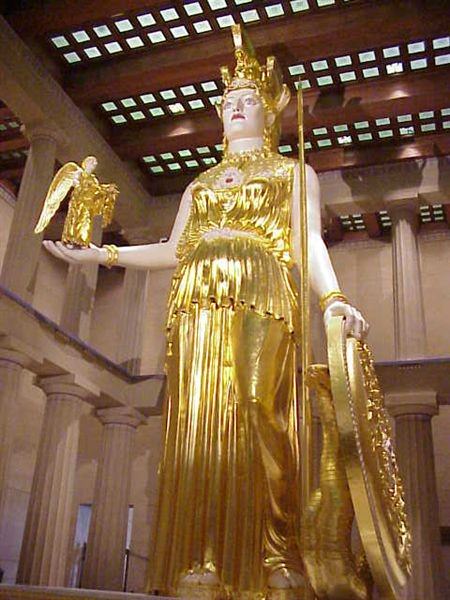
Athena Parthenos
THE MASTERPIECES
Greek sculpture is, however, not limited to standing figures. Portrait busts, relief panels, grave monuments, and objects in stone such as perirrhanteria (basins supported by three or four standing female figures) also tested the skills of the Greek sculptor. Another important branch of the art form was architectural sculpture, prevalent from the late 6th century BCE on the pediments, friezes, and metopes of temples and treasury buildings. However, it is in figure sculpture that one may find some of the great masterpieces of Classical antiquity, and testimony to their class and popularity is that copies were very often made, particularly in the Roman period. Indeed, it is fortunate that the Romans loved Greek sculpture and copied it so widely because it is often these copies which survive rather than the Greek originals. The copies, however, present their own problems as they obviously lack the original master's touch, may swap medium from bronze to marble, and even mix body parts, particularly heads.
Although words will rarely ever do justice to the visual arts, we may list here a few examples of some of the most celebrated pieces of Greek sculpture. In bronze, three pieces stand out, all saved from the sea (a better custodian of fine bronzes than people have been): the Zeus or Poseidon of Artemesium and the two warriors of Riace (all three: 460-450 BCE). The former could be Zeus (the posture is more common for that deity) or Poseidon and is a transitional piece between Archaic and Classical art as the figure is extremely life-like, but in fact, the proportions are not exact (eg the limbs are extended). However, as Boardman eloquently describes, '(it) manages to be both vigorously threatening and static in its perfect balance'; the onlooker is left in no doubt at all that this is a great god. The Riace warriors are also magnificent with the added detail of finely sculpted hair and beards. More Classical in style, they are perfectly proportioned and their poise is rendered in such a way as to suggest that they may well step off of the plinth at any moment.
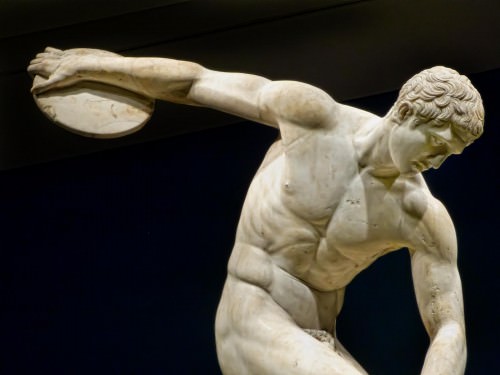
The Diskobolos (Discus Thrower)
In marble, two standout pieces are the Diskobolos or discus thrower attributed to Myron (c. 450 BCE) and the Nike of Paionios at Olympia (c. 420 BCE). The discus thrower is one of the most copied statues from antiquity and it suggests powerful muscular motion caught for a split second, as in a photo. The piece is also interesting because it is carved in such a way (in a single plain) as to be seen from one viewpoint (like a relief carving with its background removed). The Nike is an excellent example of the 'wet-look' where the light material of the clothing is pressed against the contours of the body, and the figure seems semi-suspended in the air and only just to have landed her toes on the plinth.
CONCLUSION
Greek sculpture then, broke free from the artistic conventions which had held sway for centuries across many civilizations, and instead of reproducing figures according to a prescribed formula, they were free to pursue the idealised form of the human body. Hard, lifeless material was somehow magically transformed into such intangible qualities as poise, mood, and grace to create some of the great masterpieces of world art and inspire and influence the artists who were to follow in Hellenistic and Roman times who would go on to produce more masterpieces such as the Venus de Milo. Further, the perfection in proportions of the human body achieved by Greek sculptors continues to inspire artists even today. The great Greek works are even consulted by 3D artists to create accurate virtual images and by sporting governing bodies who have compared athletes bodies with Greek sculpture to check abnormal muscle development achieved through the use of banned substances such as steroids.
Early Christianity › Origins
Ancient Civilizations
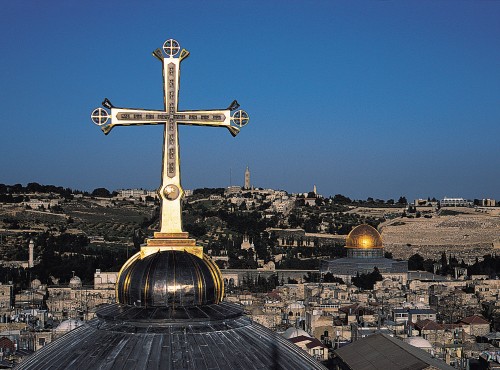
Golgotha Crucifix, Jerusalem
ROOTS IN SECOND TEMPLE JUDAISM
Jews claimed an ancient tradition with law codes for daily life (the Laws of Moses ) and revelations from their god through Prophets. While recognizing various powers in the universe, Jews nevertheless differed from their neighbors by only offering worship (sacrifices) to their one god, Yahweh. After suffering several national defeats by the Assyrians in 722 BCE and the Babylonians in 587 BCE, their prophets claimed that God would eventually restore Israel to its former independence. In those 'final days' ( eschaton in Greek ), God would designate a descendant of David, an 'anointed one' ( Messiah in Hebrew, or Christos in Greek), who would lead the righteous against the enemies of Israel. God would then establish a new Eden, which came to be known as 'the kingdom of God.'
After a short-lived rebellion against Greek rule (the Maccabean Revolt, 167 BCE), Galilee and Judea were conquered by Rome (63 BCE). By the 1st century CE, many messiah figures rallied Jews to call upon God to help them overthrow the overlords. Most of these figures were killed by Rome for stirring up mobs against law and order. A sect of Jews known as Zealots convinced the nation to rebel against Rome in 66 CE, which ended in the destruction of Jerusalem and their temple (70 CE).
From all of the evidence, Jesus of Nazareth was an end-time preacher, or an apocalyptic prophet, proclaiming that the kingdom of God was imminent. He was crucified by Rome (between 26-36 CE), perhaps for stirring up crowds at the festival of Passover. Crucifixion was the Roman penalty for rebels and traitors; preaching a kingdom other than Rome was subversive.Shortly after his death, his disciples claimed that he had risen from the dead. Whatever this experience was, it motivated them to mission or to spread the 'good news' ('gospel') that the kingdom of God would arrive soon.
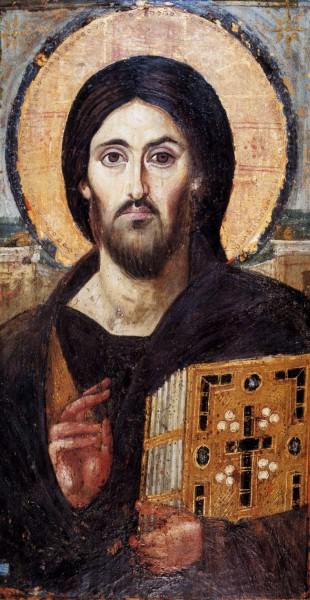
Jesus Christ
The followers of Jesus first took this message to the synagogue communities of Jews in the Eastern part of the Roman Empire. Many Jews did not believe that Jesus was the expected Messiah, but to the surprise of these apostles (messengers), Gentiles (pagans) wanted to join the movement. This unexpected occurrence raised questions of inclusion: should these pagans become Jews first, entailing circumcision, dietary laws, and Sabbath observance? At a meeting in Jerusalem (ca. 49 CE, The Apostolic Council), it was decided that pagans could join without becoming Jews. However, they had to observe some Jewish principles such as draining blood from meat, sexual morality, and the cessation of all idolatry (Acts 15). By the end of the 1st century, these Gentile-Christians dominated the Christianoi (“the followers of the Christ”).
Paul, a Pharisee, was the founder of many of these communities. He claimed that Jesus told him in a vision to be his “apostle to the Gentiles.” Jesus was now in heaven but would soon return. This concept was known as the parousia (or 'second appearance'), and rationalized the problem that the kingdom did not appear during Jesus' lifetime; what the prophets proclaimed would be fulfilled upon his return. At that time, current society (and its social conventions and class distinctions) would be transformed.
JEWS COULD ACKNOWLEDGE THE EXALTATION OF JESUS TO HEAVEN AS A REWARD FOR A MARTYR'S DEATH, BUT PLACING JESUS ON THE SAME LEVEL AS GOD CREATED A BARRIER BETWEEN JEWS & CHRISTIANS.
With the belief that Jesus was now in heaven, Christ became an object of worship. Paul claimed that Christ had been present at creation, and that “every knee show bow” before him (Phil. 2). In the fourth gospel of John, Christ was identified as the philosophical principle of the logos, or the rational principle of the universe that became flesh (the doctrine of the Incarnation).We have very little information on how early Christians worshipped Christ. Worship in the ancient world consisted of sacrifices.For Jews (and then Christians), this element was removed with the destruction of their Temple in 70 CE. At the same time, ex-pagan Christians ceased the traditional sacrifices of the native cults.
In the Acts of the Apostles, we have stories of Peter and John healing people “in the name of Jesus.” There was an initiation rite of baptism, hymns and prayers to Christ, and a meal known as the Last Supper, a memorial of Jesus' last teaching.Christians addressed Jesus as 'Lord,' which was also a Jewish title for god. Jews could acknowledge the exaltation of Jesus to heaven as a reward for a martyr's death, but placing Jesus on the same level as God created a barrier between Jews and Christians.
THE SPREAD OF CHRISTIANITY
In Greco-Roman culture people claimed ethnic identity from ancestors; you were literally born into your customs and beliefs.Conversion (moving from one religious worldview to another) was not common as your religion was in the blood. Christianity taught that ancestry and bloodlines were no longer relevant. According to Paul, faith ( pistis, 'loyalty') in Christ was all that was needed for salvation. This new idea resulted in a religious movement no longer confined to a geographic area or an ethnic group. Christianity became a portable religion available to all.
The idea of salvation was another innovation. Jews had articulated salvation as the restoration of the nation of Israel. Pagans had no similar concept but some did have concerns about their existence in the afterlife. Paul wrote that Christ's death was a sacrifice that eliminated the punishment for the sin of Adam which was death (the doctrine of atonement). For this first generation of Christians, physical death was no longer a reality; they would be transformed into “spiritual bodies” when Christ returned (1 Cor. 15). As time passed and Christ did not return, Christians accepted the death of the body but were promised a reward in heaven.
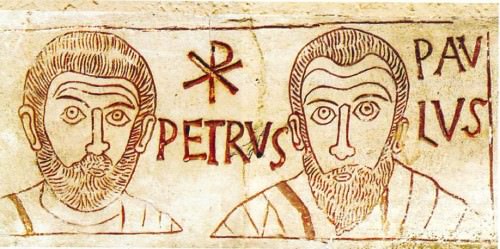
Saints Peter and Paul, from a catacomb etching
Christianity shared some elements with the Mystery cults (such as Demeter and Dionysus) that were popular in the Hellenistic period. These cults required initiation and offered secret information on both an improved life in this world as well as a smooth transition to a good afterlife. The Mysteries also utilized the concept of a dying and rising god.
Christianity did not spread overnight “like wildfire” as it was previously suggested. Initiates spent three years learning Christian teachings, followed by their baptism, which was usually held on what became the feast day of Easter. The initiate was naked as an indication of a rejection of their former life, submerged in the water, and then donned a new robe as the sign of being "reborn". Adult baptism was the norm until roughly the 4th and 5th centuries CE when infant baptism became the norm due to high infant mortality rates.
HIERARCHY, CELIBACY & MONASTICISM
Christianity did spread far and wide, with small communities as far away as Britain and sub-Saharan Africa. However, there was no central authority, such as the Vatican, to validate various beliefs and practices. Numerous and diverse groups existed throughout the Empire. Bishops communicated with each other and their letters demonstrate often rancorous debates.
Christians adopted the Greek system of political assemblies ( ecclesia in Greek, English 'church') and the Roman system of an overseer (bishop) of a section of a province (a diocese). In the 1st century CE, bishops were elected as administrative leaders.An innovation in the office of bishop occurred sometime between the 1st and 2nd centuries CE. Bishops now had the power to absolve sins through their possession by the Holy Spirit. Deacons were elected initially as helpers in distributing charity and eventually became priests.
CHURCH FATHERS EXPRESSED A DISDAIN FOR PAGAN ATTITUDES TOWARD THE BODY, INFLUENCED BY SIMILAR PHILOSOPHICAL VIEWS KNOWN AS ASCETICISM.
The pagan worldview included the importance of fertility (of crops, herds, and people) for survival. Sexual intercourse was considered necessary, natural, and enjoyable for both gods and humans. The Church Fathers expressed a disdain for these attitudes toward the body, influenced by similar philosophical views known as asceticism. Church leaders advocated celibacy (no marriage) and chastity (no sexual relations) as requisites for bishops and other leadership positions.
Beyond the leadership, Christians were encouraged to marry, recognizing the biblical command “to be fruitful and multiply.” However, sexual intercourse was limited to the sole purpose of procreation. Intercourse, when a wife was barren, was a concession to lust, now deemed a sin and something that only sexually immoral pagans indulged in.
The height of Christian asceticism was achieved by Anthony in Egypt (251-356 CE) when he turned his back on society and went to live in a cave in the desert. Others followed and were known as the Desert Fathers. They eventually were housed together in monasteries and provided an additional level of clergy, and the educated among them copied and illustrated Christian manuscripts.
PERSECUTION & MARTYRDOM
By tradition, the Emperor Nero (54-68 CE) was the first Roman official to persecute Christians. The Roman historian Tacitus (56-120 CE) claimed that Nero blamed the Christians for the Great Fire of Rome in 64 CE, although he was not a witness to the events. Nevertheless, the story has become embedded in the early history of Christianity. If Nero did indeed execute Christians, it was not official Roman policy at this time.
The decision to persecute Christians most likely began during the reign of Domitian (83-96 CE). A depleted treasury motivated Domitian to take action in two areas: he enforced the collection of the Jewish Temple tax and mandated worship at the Imperial Temples. After the destruction of their Temple, Domitian's father, Vespasian (69-79 CE), had ordered the Jews to continue paying the Temple tax, now sending it to Rome as war reparations, but apparently, no one enforced this until the reign of Domitian. In seeking out tax evaders among Jews, his officials became aware of another group who worshipped the same god but were not Jews and thus not responsible for the tax.
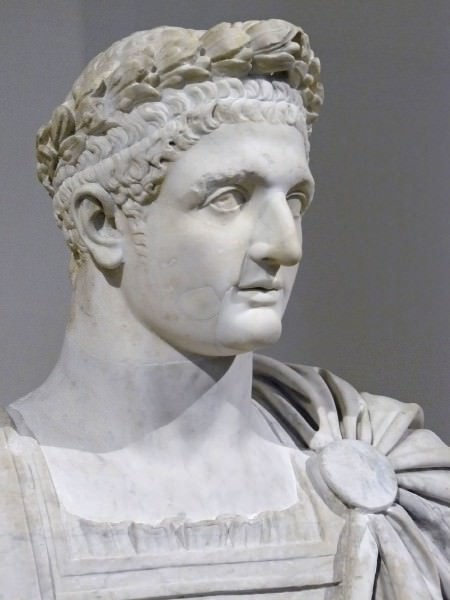
Roman Emperor Domitian
The Imperial Cult began with the deification of Julius Caesar after his death (44 BCE). The common people claimed that Caesar was now “among the gods.” Octavian created Imperial temples that both honored Caesar and the imperial family. The Imperial Cult served as propaganda and brought in funds from the sale of priesthoods. Domitian insisted on being addressed as “Lord and God” and ordered everyone to participate in his cult. Jews had been granted exemption from traditional cults by Julius Caesar as a reward for his Jewish mercenaries. Christians, however, did not have this “get out of jail free card.”
Christians were charged with the crime of atheism. Their refusal to appease the gods by sacrificing to them was perceived as a threat to the prosperity of the Empire, which was equivalent to treason. Christians were executed in the arenas, often being mauled and eaten by lions. Lions and other wild animals were utilized in the venatio games by specially-trained animal hunters ( bestiarii ). It was convenient to utilize these animals as executioners for the state.
Christians borrowed the concept of martyrdom from Judaism, where anyone who died for their faith was immediately taken into the presence of God. Martyrdom, therefore, became very attractive for Christians and many stories were told of their bravery and conviction in the face of death. Such devotion served as propaganda for the faith.
Despite Christian tradition (and Hollywood), persecution was never the subject of Empire-wide edicts until the second half of the 3rd and the beginning of the 4th centuries CE. Nor were there thousands of victims. In 300 years, we have records that indicate the sporadic nature of persecution which depended upon circumstances. Whenever there was a crisis (foreign invasion, famine, plague) Christians became scapegoats for angering the gods. In between, Romans left Christians alone for the most part.
ORTHODOXY & HERESY
The pagan world accepted the plurality of diverse approaches to the gods with an emphasis on correct rituals rather than any consensus on doctrine. The Church Fathers of the 2nd century CE developed an innovation with the concept of orthodoxy, or the idea that there was only one “correct belief.” This was matched by its polar opposite, heresy (Greek, airesis, or 'choice,' as in a choice of a particular philosophy ).
Under the umbrella term, 'Gnostics,' some Christians offered a different view of both the universe and salvation in Christ (from the Greek, gnosis, 'knowledge'). For many Gnostics, all matter in the physical universe was evil, including the human body.Christ did not manifest in a body, and therefore, the crucifixion and resurrection were not important for salvation. Rather, Christ only appeared in human form (Docetism) to reveal that humans contained a divine spark of God that was trapped in the body.Jesus' teaching provided the key to liberate this spark and help it return to its source.
ADVERSOS LITERATURE : AN IDENTITY SEPARATE FROM JUDAISM
A specific type of literature emerged in the 2nd century CE, directed against Jews and Judaism, which coincided with increased persecution of Christians. Christians claimed they should have the same exemption from state cults as the Jews because Christians were verus Israel, the “true Israel.” Christian interpretation of the Jewish Scriptures through allegory demonstrated that wherever God appeared in the Scriptures, it was actually Christ in a pre-existent form. Christians claimed the Scriptures as their own and a "new covenant" now replaced the old. The adversos literature contributed to a Christian identity now separate and distinct from Judaism in practice, but with an ancient tradition which would give them respect. These treatises were highly polemical, malicious, and full of standard rhetoric at the time against an opponent. Unfortunately, many of these arguments became the basis for the later charges against Jews in the Middle Ages and beyond.
THE CONVERSION OF CONSTANTINE
By 300 CE, Emperor Diocletian (284-305 CE) had organized the Roman Empire into East and West. When he died in 306 CE, various co-rulers vied to return to one-man rule. In the West, the battle was between Maxentius (306-312 CE) and Constantine I (306-337 CE). Constantine later told the story that the night before the battle (at the Milvian Bridge in Rome), he saw a sign in the sky (either chi and rho, the first two letters of Christ, or a cross) and heard a voice that commanded “in hoc signo vinces” (“in this sign conquer ”). Constantine claimed that he won the battle with the support of the Christian god.

Constantine I
In conjunction with the surviving ruler of the East, Licinius, The Edict of Milan was issued in 313 CE, granting Christianity the right to legally assemble without fear of arrest or persecution. Christianity now joined the hundreds of other pagan cults, although Constantine favored Christians through tax exemptions and funds for building churches.
A CHRISTIAN EMPIRE
Constantine was interested in both unifying the Empire as well as the Church. He adopted the teachings of the Church Fathers as the core of Christian belief. However, a controversial teaching by a presbyter in Alexandria, Egypt, Arius, caused riots throughout the Empire. According to Arius, if God created everything in the universe, then Christ was a creature and thus subordinate to God. In 325 CE, Constantine invited bishops to attend a meeting in Nicaea to define the relationship between God and Christ. The result was the Nicene Creed, a list of tenets that all Christians were to avow. God and Christ were of the “same essence,” both participated in creation, and therefore monotheism was maintained; God was one, with three manifestations. With the Holy Spirit of God as the manifestation of divinity on earth, this doctrine became known as the Trinity.Christians who challenged these beliefs were deemed heretics, now equivalent to treason. Their non-conformity threatened the prosperity of the now Christian Emperor and Empire.
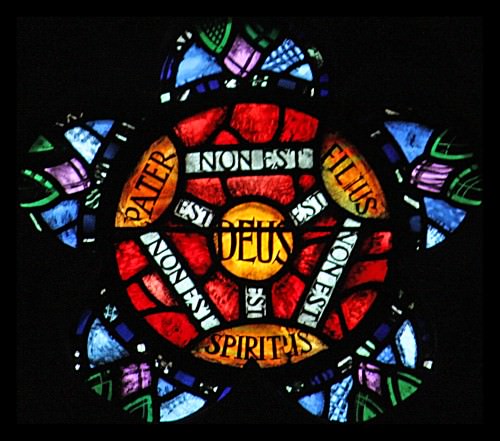
Holy Trinity
In 381 CE, Theodosius I issued an edict that banned all cults except Christianity. In the 390's CE he ordered the cessation of the Olympic Games, dedicated to the ancient gods, and the closure of pagan shrines and temples. Some of these buildings were destroyed, but others were transformed into Christian churches.
By the 4th century CE, Christians combined the Jewish concept of martyrdom with Greco-Roman concepts of patron gods/goddesses of towns and cities. Christian martyrs were now understood in a similar position as mediators in heaven. The practice of pilgrimage to their tombs became "the cult of the saints."
When Constantine moved the capital to Constantinople in 330 CE, this created a temporary void in leadership in the West.By the 5th century CE, the bishop of Rome absorbed secular leadership as well, now with the title of 'Pope.' In the Eastern Empire ( Byzantium ), the Emperor remained the head of the state as well as the head of the Church until the conquest of Constantinople (Istanbul) by the Turks in 1453 CE.
Why did Christianity succeed? The conversion of Constantine certainly provided practical reasons for pagans to adopt the new religion. However, while introducing innovations, Christianity nevertheless absorbed many shared elements from Greco-Roman culture, which undoubtedly helped to transform individuals from one worldview to another.
Ancient Greek Pottery › Origins
Definition and Origins
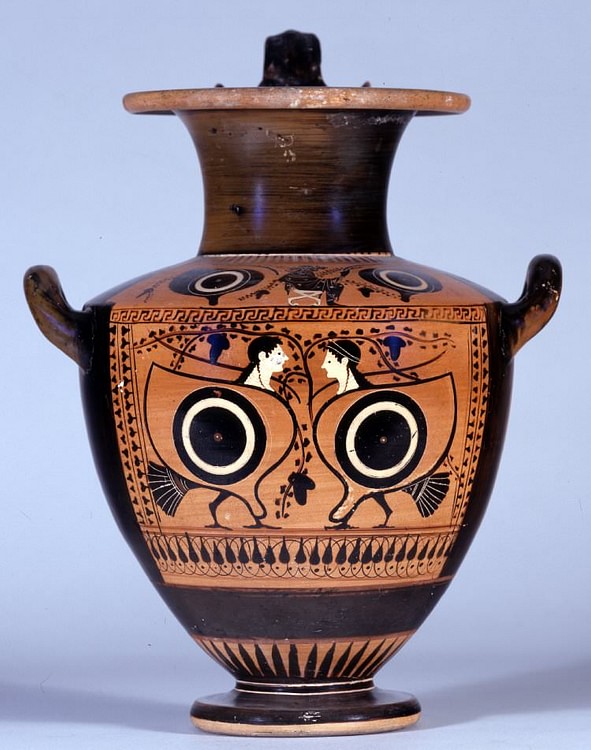
The pottery of ancient Greece from c. 1000 to c. 400 BCE provides not only some of the most distinctive vase shapes from antiquity but also some of the oldest and most diverse representations of the cultural beliefs and practices of the ancient Greeks. Further, pottery, with its durability (even when broken) and lack of appeal to treasure hunters, is one of the great archaeological survivors and is, therefore, an important tool for archaeologists and historians in determining the chronology of ancient Greece. Whatever their artistic and historical value though, the vast majority of Greek vases, despite now being dusty museum pieces, were actually meant for everyday use and, to paraphrase Arthur Lane, it is perhaps worth remembering that standing on a stone pavement and drenched with water, they would have once gleamed in the Mediterranean sun.
MATERIALS & PRODUCTION
The clay ( keramos ) to produce pottery ( kerameikos ) was readily available throughout Greece, although the finest was Attic clay, with its high iron content giving an orange-red colour with a slight sheen when fired and the pale buff of Corinth. Clay was generally prepared and refined in settling tanks so that different consistencies of material could be achieved depending on the vessel types to be made with it.
Greek pottery was invariably made on the potter's wheel and usually made in separate horizontal sections: the foot, the lower and upper body, the neck, and finally the handles, if necessary. These sections were then joined together with a clay 'slip' after drying and it is possible in many cases to see the prints of the potter impressed on the inside of the vessel. The piece was then put back on the wheel to smooth the join marks and add the final shaping. Therefore, all vases were unique and the small variations in dimensions reveal that the use of simple tools and not cut-out templates was the norm.
POTS WERE FIRED SEVERAL TIMES (IN THE SAME KILN) IN ORDER TO ACHIEVE THE REQUIRED FINISH & COLOURING.
Next, the pot was decorated. This process depended on the decorative style in vogue at the time, but popular methods included painting the whole or parts of the vase with a thin black adhesive paint which was added with a brush, the marks of which remain visible in many cases. This black paint was a mix of alkali potash or soda, clay with silicon content, and black ferrous oxide of iron. The paint was affixed to the pot by using a fixative of urine or vinegar which burned away in the heat of the kiln, binding the paint to the clay. Another technique, used more rarely, was to cover the vessel with a white clay paint.Alternatively, only lines or figures were added in black using a thicker version of the black paint mentioned above and applied with a stiff brush or feather; in consequence, a slight relief effect was achieved. Minor details were often added with a thinned black paint giving a yellow-brown colour, a white pipe-clay, and a dark red of ochre and manganese. The latter two colours tended to flake off over time.
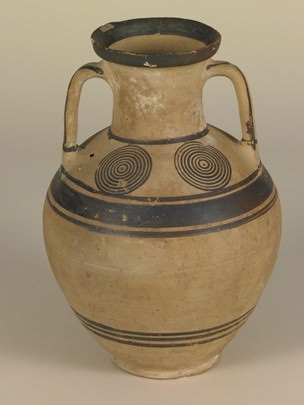
Proto-geometric Amphora
The finished pot was then ready to be put in the kiln and fired at a temperature of around 960 °C, which is relatively low and explains the 'softness' of Greek pottery (in comparison to, for example, Chinese porcelain). Pots were fired several times (in the same kiln) in order to achieve the required finish and colouring. First, the pot was fired in an oxidising fire where good ventilation to the kiln ensured that the orange/red of the clay came to the fore. Then the pot was re-fired in a kiln starved of oxygen (reduction process) by adding water or damp wood inside the kiln. This ensured that the painted colours, particularly the black, darkened in colour. A third firing, again with good ventilation, re-reddened the clay of the pot whilst the painted areas, now protected by a thin wash, kept their original colouring. This complicated process obviously required excellent timing from the potter so as not to spoil the vase with unseemly discolouring.
POTTERS & PAINTERS
Painter and potter ( kerameus ) were usually, although not always, separate specialists. However, lasting partnerships existed such as between the potter Ergotimos and painter Kleitas. Many individual potters and less frequently, painters, have been identified with certainty through their signatures (most commonly as “...made this”) although the majority of Greek vases are unsigned. However, Professor JD Beazley, working in the 20th century CE, identified more than 500 unsigned artists distinguishable through their particular style. Beazley's systematic and comprehensive cataloguing of Greek pottery has also allowed for the study of its evolution in techniques, designs, and decoration.
A GOOD GREEK VASE PROBABLY COST ONLY A DAY'S WAGES.
Painters often worked in collective workshops, generally under the supervision of one 'master' potter (which suggests form was actually more important than decoration for the Greeks). Although artists were free from centralised political control or restrictions, they no doubt were driven by the market demand for particular styles, subjects, and fashions. Many potters and artists were prolific in their output and in some cases over 200 vases may be attributed to a single artist. The majority of pottery workers would have been paid no more than any other manual labourer and a good vase probably cost only a day's wages. Certainly though, a few artists would have been in great demand and their goods were sold not only locally but far and wide throughout the Mediterranean. Potters themselves sometimes relocated to other cities, particularly colonies, often taking with them their regional style. There was also some rivalry between artists as indicated by one signed comment on a vase, “better than Euphronias could ever have done”.
SHAPES
Although Greek pottery provides us with a wide range of shapes from cups to plates to massive amphorae, many of the forms remained relatively constant over centuries. This is primarily because Greek potters were producing wares for practical use - holding wine, water, oil, and perfumes - and once the optimum practical shape had evolved, it was copied and maintained.However, despite this restriction in form, the Greek potters and painters could express their versatility in the decoration of the vase.
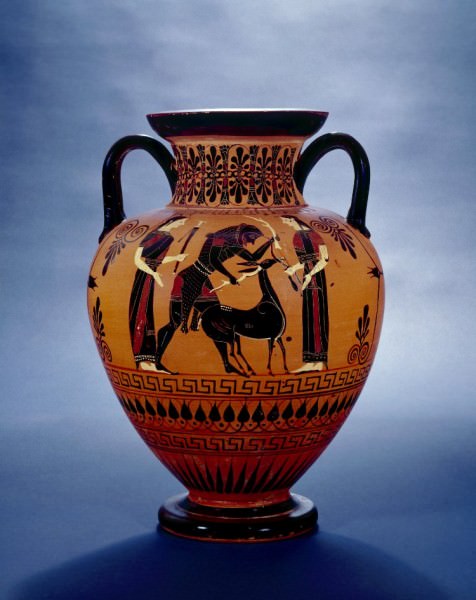
Attic Black-figure Amphora
The most common forms of pottery were amphorae for storing wine, large kraters for mixing wine with water, jugs ( oinochoai ) for pouring wine, kylixes or stemmed cups with horizontal handles for drinking (especially practical if lifting a cup from the floor when reclining on a lounger at dinner), hydra with three handles for holding water, skyphoi or deep bowls, and lekythoi jars for holding oils and perfumes. Precisely because these objects were for practical use, handles (when present) are generally sturdy affairs, yet the potter, by using carefully considered shapes, often managed to blend these additions into the overall harmony of the vessel and was aided in this endeavour with subtle decorative additions by the painter.
DECORATIVE STYLES: PROTO-GEOMETRIC POTTERY
Greek pottery, particularly in terms of decoration, evolved over the centuries and may be categorized into four broad groups:
- Proto-geometric pottery
- Geometric pottery
- Black-figure pottery
- Red-figure pottery
These groups or styles, however, did not pass abruptly from one to the other but rather in some cases ran contemporary for decades. Also, some city -states and regions were either slow to catch on to new styles or simply preferred the 'old' style decoration long after they had gone out of production elsewhere. In addition, some cities and regions were consistently a little eccentric in their decoration (notably Laconia- Sparta, Cyprus, Crete, and Boeotia) and preferred to follow their own artistic path rather than imitate the styles of the more dominant centres such as Athens and Corinth.
The first distinctive Greek pottery style first appeared around 1000 BCE or perhaps even earlier. Reminiscent in technique of the earlier Greek civilizations of Minoan Crete and the Mycenaean mainland, early Greek pottery decoration employed simple shapes, sparingly used. Proto-Geometric pottery, however, differs from Minoan and Mycenaean in shape. The centre of gravity of the vase is moved downwards (creating a more stable vessel) with the feet and neck more articulated.
The most popular Proto-Geometric designs were precisely painted circles (painted with multiple brushes fixed to a compass), semi-circles, and horizontal lines in black and with large areas of the vase painted solely in black. A new motif on the bases of vessels was the upright triangular points which would endure for centuries and become a staple feature of the later black-figure pottery design.
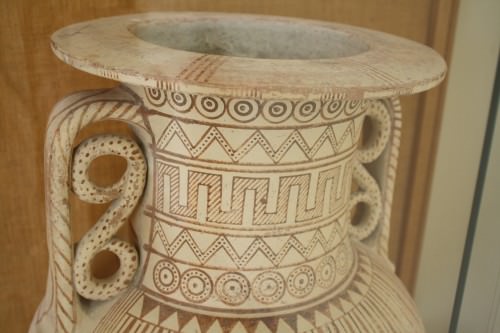
Geometric Pottery Designs
GEOMETRIC POTTERY
From around 900 BCE the full Geometric style appeared and favoured the rectangular space on the main body of the vase between the handles. Bold linear designs (perhaps influenced by contemporary basketwork and weaving styles) appeared in this space with vertical line decoration on either side.Fue en este período que apareció por primera vez el diseño Maeander (tal vez inspirado en la práctica de envolver hojas alrededor de los bordes de cuencos de metal), destinado a asociarse para siempre con Grecia y que sigue siendo fuerte en todo, desde platos hasta toallas de playa. La parte inferior de los vasos geométricos a menudo se pintaban en negro y se separaban del resto del jarrón mediante líneas horizontales. Apareció una interesante forma de estilo geométrico que era la caja circular con una tapa plana, sobre la cual, de uno a cuatro caballos actuaban como asa.
LAS FIGURAS ESTILIZADAS NEGRAS SE HICIERON MÁS Y MÁS PRECISAMENTE GRABADAS Y FUERON DADAS MÁS DETALLE, GRACIA Y VIGOR.
Desde el siglo VIII a. C., la decoración de cerámica geométrica comenzó a incluir figuras humanas estilizadas, pájaros y animales con casi toda la superficie del jarrón cubierta con líneas y formas gruesas pintadas en marrón y negro. Hacia el final del período en el siglo VII aC, el llamado estilo orientalizante se hizo popular en Corinto. Con sus conexiones comerciales orientales, la ciudad se apropió de las plantas estilizadas (por ejemplo, loto, palma y árbol de la vida), frisos de animales (por ejemplo, leones) y líneas curvas de cerámica egipcia y asiria para producir su propia versión griega única. El resto de Grecia oriental siguió su ejemplo, a menudo prefiriendo rojo sobre fondo blanco. Atenas también siguió la nueva tendencia y se generalizó con, por ejemplo, las Cícladas también produce cerámica en este nuevo estilo más libre, a menudo en jarrones muy grandes y con una decoración más espaciosa.
A finales del siglo VII aC, la cerámica protocorintia alcanzó nuevas cotas de técnica y calidad, produciendo la mejor cerámica vista hasta el momento, en el fuego, la forma y la decoración. Las figuras estilizadas negras se grabaron cada vez más y se les dio cada vez más detalles, gracia y vigor. El célebre estilo de cerámica de figuras negras nació.
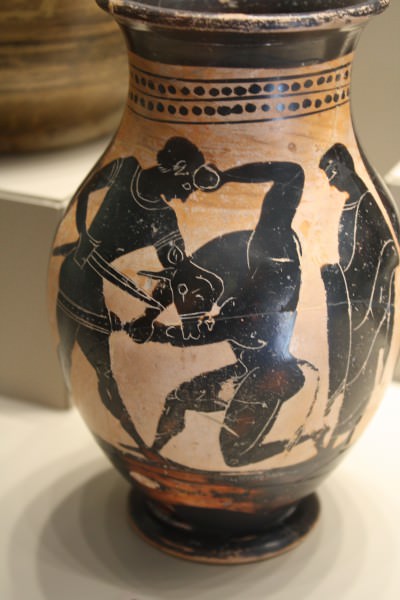
Teseo y el Minotauro
CERÁMICA DE LA FIGURA NEGRA
Aunque primero se produjo en Corinto, luego con buenos ejemplos hechos en Laconia y el sur de Italia(por los colonos de Eubea), serían los alfareros y pintores de Ática los que sobresaldrían por encima de todos los demás en el estilo de la figura negra, y continuarían dominando el mercado griego durante los siguientes 150 años. No todas las figuras estaban pintadas de negro ya que se adoptaron ciertas convenciones de color, como el blanco para la carne femenina y el rojo púrpura para la ropa y los accesorios. Un mayor interés en los detalles finos, como los músculos y el cabello, que se agregaron a las figuras con un instrumento afilado, es característico del estilo. Sin embargo, son las posturas de las figuras las que también marcan la cerámica de figuras negras como el cenit de la pintura de vasijas griegas. Las figuras más finas reciben gracia y equilibrio y, a menudo, se ilustran en los momentos anteriores al movimiento real o al descanso después del esfuerzo.
El famoso jarrón de Exekias, con Ajax y Aquiles jugando un juego de mesa durante la Guerra de Troya, es un excelente ejemplo de la dignidad y energía que la pintura de figuras negras podría lograr. Además, los jarrones de figuras negras solían contar, por primera vez, una narración. Quizás el ejemplo más célebre es el florero Francois, un gran voluta krater hecho por Ergotimos y pintado por Kleitas (570-565 aEC) que mide 66 cm de altura y está cubierto por 270 figuras humanas y animales que representan una asombrosa variedad de escenas y personajes de la mitología griega. Otros vasos típicos del estilo de figura negra son ánforas, lekythoi, kylixes, tazas sencillas,Píxidos (cajas con párpados pequeños) y cuencos.
CERÁMICA DE FIGURA ROJA
La técnica de la figura negra fue reemplazada por la técnica de la figura roja (figuras rojas creadas pintando su contorno con un fondo negro deslizado) alrededor del 530 a. C. que duraría durante los siguientes 130 años más o menos. Los dos estilos fueron paralelos durante algún tiempo e incluso hay ejemplos "bilingües" de jarrones con ambos estilos, pero la figura roja, con su ventaja del pincel sobre el graver, podría intentar representar de forma más realista la figura humana y, finalmente, se convirtió en el estilo favorito de la decoración de cerámica griega. Tal vez influenciado por técnicas contemporáneas de pintura mural, detalles anatómicos, diversas expresiones faciales, mayor detalle en la vestimenta (especialmente de pliegues, siguiendo la nueva moda del chitón más liviano vestido que también fascinó a los escultores contemporáneos), los mayores intentos de retratar la perspectiva, la superposición de figuras y la representación de la vida cotidiana, como la educación y las escenas deportivas, son características de este estilo.
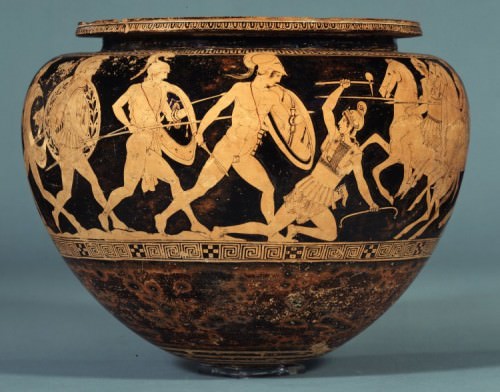
Dinos de la figura roja del ático
Las formas de los vasos de figuras rojas son generalmente las del estilo de figuras negras. Una excepción es el kylix que se vuelve menos profundo y con un pie más corto, casi convirtiéndose en un tercer mango. Además, la narración pintada debe leerse girando la copa en la mano. Otras modificaciones menores son la hidra, que se vuelve un poco más completa en la figura y el cuello- ánfora más delgado. Lekythoi de este período comúnmente tenía un fondo blanco como lo hizo (más raramente) tazas y cajas.
NUEVOS MEDIOS DE COMUNICACIÓN
En el siglo IV a. C., tal vez al intentar copiar las innovaciones en la perspectiva del fresco contemporáneo, el estilo de figura roja revelaría sus limitaciones y los jarrones degenerarían en escenas sobrecargadas con perspectivas flotantes extrañas. Significativamente, la pintura de cerámica ya no estaría vinculada intrínsecamente a la forma que decoraba y por lo tanto dejó de existir como una forma de arte en sí misma. En consecuencia, la atención y la excelencia artística se alejarían de los confinamientos de la cerámica a otros medios más abiertos, como la pintura mural.
CONCLUSION
En conclusión, entonces, podemos decir que la cerámica griega no solo nos ha dado algunas de las formas y diseños más distintivos, influyentes y bellos de la antigüedad, sino que también nos ha dado una ventana a las vidas, prácticas y creencias de un pueblo desaparecido y de quien muchas veces no tenemos un registro escrito contemporáneo. Estos objetos cotidianos, a diferencia de otras literatura, escultura y arquitectura de sobrevivientes arqueológicos, nos permiten sentirnos un poco más cerca de la gente común del mundo antiguo, aquellos que no podían permitirse las bellas artes o las joyas preciosas, pero que podían permitirse poseer una objeto como un jarrón griego.
LICENSE
Article based on information obtained from these sources:with permission from the Website Ancient History Encyclopedia
Content is available under License Creative Commons: Attribution-NonCommercial-ShareAlike 3.0 Unported. CC-BY-NC-SA License